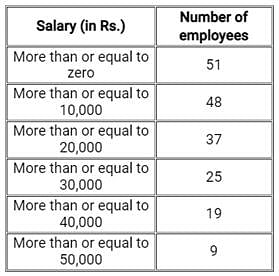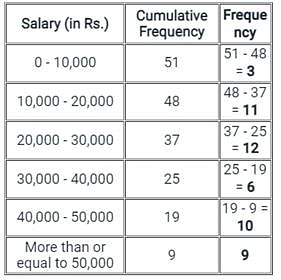ACT Exam > ACT Questions > Consider the following distribution:The frequ...
Start Learning for Free
Consider the following distribution:

The frequency of class interval 30,000 - 40,000 is:

The frequency of class interval 30,000 - 40,000 is:
- a)25
- b)12
- c)6
- d)19
Correct answer is option 'C'. Can you explain this answer?
Verified Answer
Consider the following distribution:The frequency of class interval 30...
Concept:
- Frequency of any class = cumulative frequency of class - cumulative frequency of preceding class
- Cumulative frequency is the sum of all the previous frequencies up to the current point.
Calculation:
We are already having the cumulative frequencies. Let's find out the frequencies:

Hence, the frequency of class intervals 30,000 - 40,000 is 6.

Hence, the frequency of class intervals 30,000 - 40,000 is 6.
Most Upvoted Answer
Consider the following distribution:The frequency of class interval 30...
Concept:
- Frequency of any class = cumulative frequency of class - cumulative frequency of preceding class
- Cumulative frequency is the sum of all the previous frequencies up to the current point.
Calculation:
We are already having the cumulative frequencies. Let's find out the frequencies:

Hence, the frequency of class intervals 30,000 - 40,000 is 6.

Hence, the frequency of class intervals 30,000 - 40,000 is 6.

|
Explore Courses for ACT exam
|

|
Similar ACT Doubts
Consider the following distribution:The frequency of class interval 30,000 - 40,000 is:a)25b)12c)6d)19Correct answer is option 'C'. Can you explain this answer?
Question Description
Consider the following distribution:The frequency of class interval 30,000 - 40,000 is:a)25b)12c)6d)19Correct answer is option 'C'. Can you explain this answer? for ACT 2025 is part of ACT preparation. The Question and answers have been prepared according to the ACT exam syllabus. Information about Consider the following distribution:The frequency of class interval 30,000 - 40,000 is:a)25b)12c)6d)19Correct answer is option 'C'. Can you explain this answer? covers all topics & solutions for ACT 2025 Exam. Find important definitions, questions, meanings, examples, exercises and tests below for Consider the following distribution:The frequency of class interval 30,000 - 40,000 is:a)25b)12c)6d)19Correct answer is option 'C'. Can you explain this answer?.
Consider the following distribution:The frequency of class interval 30,000 - 40,000 is:a)25b)12c)6d)19Correct answer is option 'C'. Can you explain this answer? for ACT 2025 is part of ACT preparation. The Question and answers have been prepared according to the ACT exam syllabus. Information about Consider the following distribution:The frequency of class interval 30,000 - 40,000 is:a)25b)12c)6d)19Correct answer is option 'C'. Can you explain this answer? covers all topics & solutions for ACT 2025 Exam. Find important definitions, questions, meanings, examples, exercises and tests below for Consider the following distribution:The frequency of class interval 30,000 - 40,000 is:a)25b)12c)6d)19Correct answer is option 'C'. Can you explain this answer?.
Solutions for Consider the following distribution:The frequency of class interval 30,000 - 40,000 is:a)25b)12c)6d)19Correct answer is option 'C'. Can you explain this answer? in English & in Hindi are available as part of our courses for ACT.
Download more important topics, notes, lectures and mock test series for ACT Exam by signing up for free.
Here you can find the meaning of Consider the following distribution:The frequency of class interval 30,000 - 40,000 is:a)25b)12c)6d)19Correct answer is option 'C'. Can you explain this answer? defined & explained in the simplest way possible. Besides giving the explanation of
Consider the following distribution:The frequency of class interval 30,000 - 40,000 is:a)25b)12c)6d)19Correct answer is option 'C'. Can you explain this answer?, a detailed solution for Consider the following distribution:The frequency of class interval 30,000 - 40,000 is:a)25b)12c)6d)19Correct answer is option 'C'. Can you explain this answer? has been provided alongside types of Consider the following distribution:The frequency of class interval 30,000 - 40,000 is:a)25b)12c)6d)19Correct answer is option 'C'. Can you explain this answer? theory, EduRev gives you an
ample number of questions to practice Consider the following distribution:The frequency of class interval 30,000 - 40,000 is:a)25b)12c)6d)19Correct answer is option 'C'. Can you explain this answer? tests, examples and also practice ACT tests.

|
Explore Courses for ACT exam
|

|
Signup for Free!
Signup to see your scores go up within 7 days! Learn & Practice with 1000+ FREE Notes, Videos & Tests.


























